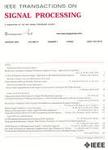版权所有:内蒙古大学图书馆 技术提供:维普资讯• 智图
内蒙古自治区呼和浩特市赛罕区大学西街235号 邮编: 010021

作者机构:Program of Electrical Engineering (PEE) Federal University of Rio de Janeiro (UFRJ) ET-PROSUB Marine Bresilienne (Brazilian Navy Technical Office in France) HOUILLES France Electrical Engineering Program—COPPE/UFRJ Rio de Janeiro RJ Brazil Department of Electrical Engineering (SE/3)—Lab Instituto Militar de Engenharia Praça General Tibúrcio Brazil
出 版 物:《IEEE Transactions on Signal Processing》
年 卷 期:2015年第63卷第24期
页 面:6524-6539页
主 题:Signal processing algorithms Antenna arrays Least mean square algorithms Convergence Array signal processing Sensor arrays
摘 要:We detail in this paper an L 1 -norm Linearly constrained normalized least-mean-square (L 1 -CNLMS) algorithm and its weighted version (L 1 -WCNLMS) applied to solve problems whose solutions have some degree of sparsity, such as the beamforming problem in uniform linear arrays, standard hexagonal arrays, and (non-standard) hexagonal antenna arrays. In addition to the linear constraints present in the CNLMS algorithm, the L 1 -WCNLMS and the L 1 -CNLMS algorithms take into account an L 1 -norm penalty on the filter coefficients, which results in sparse solutions producing thinned arrays. The effectiveness of both algorithms is demonstrated via computer simulations. When employing these algorithms to antenna array problems, the resulting effect due to the L 1 -norm constraint is perceived as a large aperture array with few active elements. Although this work focuses the algorithm on antenna array synthesis, its application is not limited to them, i.e., the L 1 -CNLMS is suitable to solve other problems like sparse system identification and signal reconstruction, where the weighted version, the L 1 -WCNLMS algorithm, presents superior performance compared to the L 1 -CNLMS algorithm.